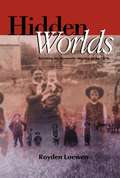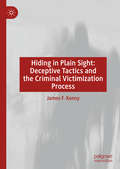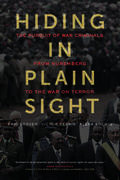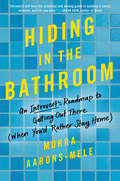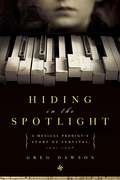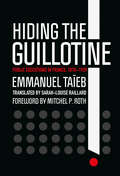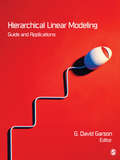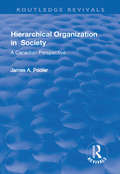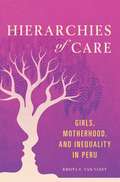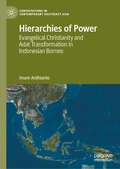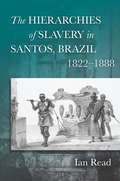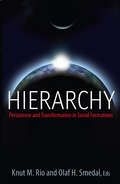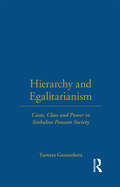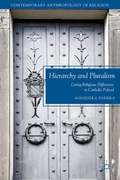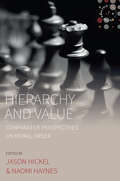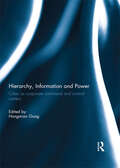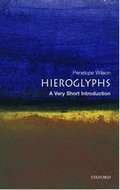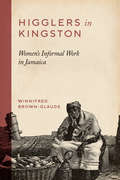- Table View
- List View
Hidden Wisdom: Secrets of the Western Esoteric Tradition
by Tim Wallace-Murphy“The best book about the secret tradition I’ve read for many years. Tim Wallace-Murphy writes with style, passion and truth. A magnificent achievement.” —Graham Hancock, New York Times–bestselling author of Fingerprints of the GodsFrom Egyptian mythology to Jewish mysticism, Rome and Greece to the druids and the gnostics, Tim Wallace-Murphy exposes a fascinating lineage of hidden mysteries and secret societies, continuing through the Templars, Rosicrucians, and Freemasons to our modern visionaries. This hidden stream of spirituality and that of sacred knowledge are inseparably entwined to form the single most important continuous strand in the entire Western esoteric tradition.This tradition exerted a seminal influence on the thinking of the builders of the great cathedrals/ leading teachers in ecclesiastical schools/ philosophers/ playwrights/ poets such as Shakespeare, Goethe, Blake, and W. B. Yeats/ and on artists and Renaissance giants such as Leonardo da Vinci and Michelangelo. It is also the root from which sprang alchemy and modern science.Now, as more people are looking to find information on the alternatives to dominant religions and dogmas that have told us what to think and how to behave, as faith has been questioned by religious scandals, economic meltdowns, and an increasingly sick planet Earth, Wallace-Murphy reveals the secrets of the masters, including invaluable spiritual insights into everyday life that have been hidden throughout the ages. He shows us who kept this spiritual tradition alive despite appalling persecution, so that we in the twenty-first century might benefit from its accumulated fruits and ennoble our lives.Hidden Wisdom will be of immense interest to readers of the number-one bestseller The Lost Symbol as it explains much of Dan Brown’s focus on the ancient mysteries.
Hidden Worlds: Revisiting the Mennonite Migrants of the 1870s
by Royden LoewenIn the 1870s, approximately 18,000 Mennonites migrated from the southern steppes of Imperial Russia (present-day Ukraine) to the North American grasslands. They brought with them an array of cultural and institutional features that indicated they were a "transplanted" people. What is less frequently noted, however, is that they created in their everyday lives a world that ensured their cultural longevity and social cohesiveness in a new land.Their adaptation to the New World required new concepts of social boundary and community, new strategies of land ownership and legacy, new associations, and new ways of interacting with markets. In Hidden Worlds, historian Royden Loewen illuminates some of these adaptations, which have been largely overshadowed by an emphasis on institutional history, or whose sources have only recently been revealed. Through an analysis of diaries, wills, newspaper articles, census and tax records, and other literature, an examination of inheritance practices, household dynamics, and gender relations, and a comparison of several Mennonite communities in the United States and Canada, Loewen uncovers the multi-dimensional and highly resourceful character of the 1870s migrants.
The Hidden Wound
by Wendell BerryWith the expected grace of Wendell Berry comes The Hidden Wound, an essay about racism and the damage it has done to the identity of our country. Through Berry's personal experience, he explains how remaining passive in the face of the struggle of racism further corrodes America's potential. In a quiet and observant manner, Berry opens up about how his attempt to discuss racism is rooted in the hope that someday the historical wound will begin to heal.
Hiding in Plain Sight: Deceptive Tactics and the Criminal Victimization Process
by James F. KennyThis book examines the role of deceptive tactics in the criminal victimization process, showing how various forms of manipulative aggression can help disguise dangerous advances. The author approaches crime victimization as the final stage in a purposeful, predictable, dynamic, and progressively dangerous process involving interactions between the target and the aggressor. As they prepare for the attack, aggressors may attempt to distract, confuse, and reduce target resistance. While these tactics provide aggressors certain advantages, they can be recognized, anticipated, and managed. By presenting a framework to identify behaviors of concern early in the process, Kenny shows how preventative action can be taken. Proactive intervention may cause aggressors to withdraw before they are fully committed to and confident in their ability to be successful. Those who take steps to reduce vulnerabilities, limit risky behaviors, and avoid dangerous situations can help prevent themselves from being victimized.
Hiding in Plain Sight
by Alexa Koenig Victor Peskin Eric StoverHiding in Plain Sight tells the story of the global effort to apprehend the world's most wanted fugitives. Beginning with the flight of tens of thousands of Nazi war criminals and their collaborators after World War II, then moving on to the question of justice following the recent Balkan wars and the Rwandan genocide, and ending with the establishment of the International Criminal Court and America's pursuit of suspected terrorists in the aftermath of 9/11, the book explores the range of diplomatic and military strategies--both successful and unsuccessful--that states and international courts have adopted to pursue and capture war crimes suspects. It is a story fraught with broken promises, backroom politics, ethical dilemmas, and daring escapades--all in the name of international justice and human rights.Hiding in Plain Sight is a companion book to the public television documentary Dead Reckoning: Postwar Justice from World War II to The War on Terror. For more information about the documentary, visit www.saybrookproductions.com. For information about the Human Rights Center, visit hrc.berkeley.edu.
Hiding in the Bathroom: An Introvert's Roadmap to Getting Out There (When You'd Rather Stay Home)
by Morra Aarons-Mele“Introverts will love this practical and moving guide to building a career, network, and life you love.” - Susan Cain, author of Quiet From the marketing guru and host of the popular podcast Hiding in the Bathroom, a breakthrough introverts' guide that broadens the conversation sparked by Quiet and moves away from the "Lean In" approach, offering wisdom and practical tips to help readers build strong relationships and achieve their own definition of professional success.Most ambitious people believe that reaching the peaks of success means being on 24/7—tirelessly networking, deal-making, and keynoting conferences. This is nonsense, says Morra Aarons-Mele. As an eminent entrepreneur with a flourishing business and a self-proclaimed introvert with lots of anxieties, Morra disagrees with the notion that there’s only one successful "type": the intense, super social, sleep-deprived mover and shaker, the person who musters endless amounts of "grit." Hiding in the Bathroom is her antidote for everyone who is fed up with feeling like they must always "lean in"—who prefer those moments of hiding in the bathroom to constantly climbing the ladder or working the room.Morra knows what it takes to make your mark, and now, this entrepreneur who has boosted the online strategy of clients such as the Malala Fund, President Obama, the UN Foundation, and the Bill and Melinda Gates Foundation shares the insights, tricks, and knowledge she’s learned. Filled with advice, exercises to help readers evaluate their own work/life fit and manage anxiety, valuable tools, and stories of countless successful people—entrepreneurs, academics, and novices just beginning their careers—Hiding in the Bathroom empowers professionals of all ages and levels to take control and build their own versions of success. Thoughtful and practical, it is a must-have handbook for building a fantastic, prosperous career and a balanced, happy life—on your own terms.
Hiding in the Light: On Images and Things (Comedia)
by Dick HebdigeDick Hebdige looks at the creation and consumption of objects and images as diverse as fashion and documentary photographs, 1950's streamlined cars, Italian motor scooters, 1980's 'style manuals', Biff cartoons, the Band Aid campaign, Pop Art and promotional music videos. He assesses their broad cultural significance and charts their impact on contemporary popular tastes.
Hiding in the Spotlight: A Musical Prodigy's Story of Survival, 1941-1946
by Greg DawsonZhanna, a young Jewish girl from Ukraine and a gifted piano prodigy giving concerts by the age of six, manages to escape the famed Nazi death march to Dorbitsky Yar and uses her musical gift to help her survive. Giving concerts for the occupying German troops as they move throughout Europe, Zhanna keeps her true identity a secret until a young American soldier adopts her. Upon her emigration to America, Zhanna's gift flourishes and she becomes one of the first Jewish refugees to enter Julliard.
Hiding the Guillotine: Public Executions in France, 1870–1939
by Emmanuel TaïebHiding the Guillotine examines the question of state involvement in violence by tracing the evolution of public executions in France. Why did the state move executions from the bloody and public stage of the guillotine to behind prison doors? In a fascinating exploration of a grim subject, Emmanuel Taïeb exposes the rituals and theatrical form of the death penalty and tells us who watched, who participated in, and who criticized (and ultimately brought an end to) a spectacle that the state called "punishment." France's abolition of the death penalty in 1981 has long overshadowed its suppression of public executions over forty years earlier. Since the Revolution, executions attracted tens of thousands of curious onlookers. But, gradually, there was a shift in attitude and the public no longer saw this as a civilized pastime. Why? Combining material from legal archives, police files, an executioner's notebooks, newspaper clippings, and documents relating to 566 executions, Hiding the Guillotine answers this question.Taïeb demonstrates the ways in which the media was at the vanguard of putting an end to the publicity surrounding the death penalty. The press had ample reason to be critical: cities were increasingly being used for leisure activity and prisons for those accused of criminal activity. The agitation surrounding each execution, coupled with a growing identification with the condemned, would blur these boundaries. Ranked among the top hundred history books by the website, Café du Web Historizo, Hiding the Guillotine has much to impart to students of legal history, human rights, and criminology, as well as to American historians.
Hierarchical Linear Modeling: Guide and Applications
by Professor G. David GarsonThis book provides a brief, easy-to-read guide to implementing hierarchical linear modeling using three leading software platforms, followed by a set of original how-to applications articles following a standardard instructional format. The "guide" portion consists of five chapters by the editor, providing an overview of HLM, discussion of methodological assumptions, and parallel worked model examples in SPSS, SAS, and HLM software. The "applications" portion consists of ten contributions in which authors provide step by step presentations of how HLM is implemented and reported for introductory to intermediate applications.
Hierarchical Organization in Society
by James A PoolerThis title was first publiished in 2000: A hierarchy is an organization system that is structured in a treelike manner, with levels of status or authority stacked one above the other. The classical and best known example of a hierarchy is probably the typical diagram that describes the structure of a company or business, also known as the corporate ladder. This text argues that hierarchies are one of the most important concepts we have in order to understand the world around us, and looks at hierarchies in a wide variety of areas of interest to everybody, such as companies, educational systems, transport systems, retail stores, corporations, communities, population migrations, medical systems, and many other real-world phenomena. From a Canadian perspective, the text examines these hierarchies and their effects at a variety of scales. It discusses how to understand the system around us and the ones in which we are immersed every day. The central theme is that it is possible to get a better grip on the past, present and future of the world, if it is viewed through an understanding of hierarchies.
Hierarchies of Care: Girls, Motherhood, and Inequality in Peru (Interp Culture New Millennium #1)
by Krista E Van VleetPalomitáy is an orphanage in highland Peru that provides a home for unmarried mothers as young as twelve years old. In their ordinary lives, these young women encounter diverse social expectations and face moral dilemmas. They endeavor to create a ‘good life’ for themselves and their children in a context complicated by competing demands, economic uncertainties, and structured relations of power. Drawing on a year of qualitative on-site research, Krista E. Van Vleet offers a rich ethnography of Palomitáy's young women. She pays particular attention to the moral entanglements that emerge via people's efforts to provide care amid the inequalities and insecurities of today's Peru. State and nonstate participants involved in the women's intimate lives influence how the women see themselves as mothers, students, and citizens. Both deserving of care and responsible for caring for others, the young women must navigate practices interwoven with a range of a racial, gendered, and class hierarchies. Groundbreaking and original, Hierarchies of Care highlights the moral engagement of young women seeking to understand themselves and their place in society in the presence of circumstances that are both precarious and full of hope.
Hierarchies of Power: Evangelical Christianity and Adat Transformation in Indonesian Borneo (Contestations in Contemporary Southeast Asia)
by Imam ArdhiantoThis book focuses on a Pentecostal-Evangelical Kenyah community in central Borneo, a region that crosses the border between Malaysia and Indonesia. The book argues that the Pentecostal-Evangelical (P/e) mode of religious authority and organization has the capacity to adapt to both the pre-existing hierarchical traditional institution such as Adat and modern egalitarian social forms. It has been necessary within the context of Kenyah’s experience of religious change as it enabled many actors from various social classes to obtain and perceive religious authority in a specific local and regional political-religious situation while promoting their identity as egalitarian and autonomous modern subjects. In contrast with other studies on the P/e church that emphasize its egalitarian spirit as a factor that supports its impressive growth, the book contends that its adaptive structural characteristics have enabled the development of this specific Christian denomination to expand rapidly and play a dominant position in contemporary social life in various parts of the world. The book thus provides novel findings in the study of religious change in Southeast Asia by enriching the discussion of historical transformation in the region, and analyzing the articulation of global and regional Christian movements, with the socio-political characteristics of Bornean society.
The Hierarchies of Slavery in Santos, Brazil, 1822-1888
by Ian ReadDespite the inherent brutality of slavery, some slaves could find small but important opportunities to act decisively. The Hierarchies of Slavery in Santos, Brazil, 1822-1888explores such moments of opportunity and resistance in Santos, a Southeastern township in Imperial Brazil. It argues that slavery in Brazil was hierarchical: slaves' fleeting chances to form families, work jobs that would not kill or maim, avoid debilitating diseases, or find a (legal or illegal) pathway out of slavery were highly influenced by their demographic background and their owners' social position. By tracing the lives of slaves and owners through multiple records, the author is able to show that the cruelties that slaves faced were not equally shared. One important implication is that internal stratification likely helped perpetuate slavery because there was the belief, however illusionary, that escaping captivity was not necessary for social mobility.
Hierarchy: Persistence and Transformation in Social Formations
by Knut M. Rio Olaf H. SmedalLouis Dumont's concept of hierarchy continues to inspire social scientists. Using it as their starting point, the contributors to this volume introduce both fresh empirical material and new theoretical considerations. On the basis of diverse ethnographic contexts in Oceania, Asia, and the Middle East they challenge some current conceptions of hierarchical formations and reassess former debates - of post-colonial and neo-colonial agendas, ideas of "democratization" and "globalization," and expanding market economies - both with regard to new theoretical issues and the new world situation.
Hierarchy and Egalitarianism: Caste, Class and Power in Sinhalese Peasant Society (London School Of Economics Monographs On Social Anthropology Ser. #No. 65)
by Tamara GunasekeraA comprehensive analysis of stratification in rural Sri Lanka, taking into account the hierarchies of class, status and power.
Hierarchy and Pluralism
by Agnieszka PasiekaBased on an ethnographic study of rural Poland, this book investigates the challenges of maintaining pluralism in a religiously homogenous society. By examining a multireligious and multiethnic community, Pasieka reveals paradoxes inscribed into the practice and discourse of pluralism.
Hierarchy and Value: Comparative Perspectives on Moral Order (Studies in Social Analysis #7)
by Jason Hickel Naomi HaynesGlobalization promised to bring about a golden age of liberal individualism, breaking down hierarchies of kinship, caste, and gender around the world and freeing people to express their true, authentic agency. But in some places globalization has spurred the emergence of new forms of hierarchy—or the reemergence of old forms—as people try to reconstitute an imagined past of stable moral order. This is evident from the Islamic revival in the Middle East to visions of the 1950s family among conservatives in the United States. Why does this happen and how do we make sense of this phenomenon? Why do some communities see hierarchy as desireable? In this book, leading anthropologists draw on insightful ethnographic case studies from around the world to address these trends. Together, they develop a theory of hierarchy that treats it both as a relational form and a framework for organizing ideas about the social good.
Hierarchy, Information and Power: Cities as Corporate Command and Control Centers
by Hongmian GongThis book is a collection of selected papers presented in the 2012 annual meeting of the Association of American Geographers in New York honoring James O. Wheeler (1938-2010). The eight papers are informed and inspired by James O. Wheeler's many contributions to urban geography, particularly in the areas of urban hierarchy, information flows, cities in the telecommunications age, and cities as corporate command and control centers. They adopt and extend Jim Wheeler’s corporate and/or hierarchical approaches to discuss institutional investment in the U.S., corporate interlocking directorates and fast-growing firms in Canada, corporate intangible assets in South Korea, urban development in Beijing and Macau, and social and cultural diversity of global cities such as New York. Although these two approaches are not the fanciest ones in today's urban geography, they are essential to the understanding of how urban areas are connected and what drives this interconnectedness in this age of globalization. This book was previously published as a special issue of Urban Geography.
Hieroglyphs: A Very Short Introduction
by Penelope WilsonHieroglyphs were far more than a language. They were an omnipresent and all-powerful force in communicating the messages of ancient Egyptian culture for over three thousand years; used as monumental art, as a means of identifying Egyptianness, and for rarefied communication with the gods. In this exciting new study, Penelope Wilson explores the cultural significance of the script with an emphasis on previously neglected areas such as cryptography, the continuing decipherment into modern times, and examines the powerful fascination hieroglyphs still hold for us today.
Higglers in Kingston: Women's Informal Work in Jamaica
by Winnifred Brown-GlaudeMaking a living in the Caribbean requires resourcefulness and even a willingness to circumvent the law. Women of color in Jamaica encounter bureaucratic mazes, neighborhood territoriality, and ingrained racial and cultural prejudices. For them, it requires nothing less than a herculean effort to realize their entrepreneurial dreams. In Higglers in Kingston, Winnifred Brown-Glaude puts the reader on the ground in frenetic urban Kingston, the capital and largest city in Jamaica. She explores the lives of informal market laborers, called "higglers," across the city as they navigate a corrupt and inaccessible "official" Jamaican economy. But rather than focus merely on the present-day situation, she contextualizes how Jamaica arrived at this point, delving deep into the island's history as a former colony, a home to slaves and masters alike, and an eventual nation of competing and conflicted racial sectors.Higglers in Kingston weaves together contemporary ethnography, economic history, and sociology of race to address a broad audience of readers on a crucial economic and cultural center.
High Altitude Geoecology
by Patrick J. WebberThis book is concerned with section 6 of the United Nations Educational, Scientific, and Cultural Organization (UNESCO) program, "Impact of Human Activities on Temperate and Tropical Mountain and Tundra Ecosystems."
The High-Beta Rich
by Robert Frankhigh-beta rich (hi be'ta rich) 1. a newly discovered personality type of the America upper class prone to wild swings in wealth. 2. the winners (and occasional losers) in an economy that creates wealth from financial markets, asset bubbles and deals. 3. derived from the Wall Street term "high-beta," meaning highly volatile or prone to booms and busts. 4. an elite that's capable of wreaking havoc on communities, jobs, government finances, and the consumer economy. 5. a new Potemkin plutocracy that hides a mountain of debt behind the image of success, and is one crisis away from losing their mansions, private jets and yachts.The rich are not only getting richer, they are becoming more dangerous. Starting in the early 1980s the top one percent broke away from the rest of us to become the most unstable force in the economy. An elite that had once been the flat line on the American income charts - models of financial propriety - suddenly set off on a wild ride of economic binges. Not only do they control more than a third of the country's wealth, their increasing vulnerability to the booms and busts of the stock market wreak havoc on our consumer economy, financial markets, communities, employment opportunities, and government finances. Robert Frank's insightful analysis provides the disturbing big picture of high-beta wealth. His vivid storytelling brings you inside the mortgaged mansions, blown-up balance sheets, repossessed Bentleys and Gulfstreams, and wrecked lives and relationships:* How one couple frittered away a fortune trying to build America's biggest house --90,000 square feet with 23 full bathrooms, a 6,000 square foot master suite with a bed on a rotating platform--only to be forced to put it on the market because "we really need the money". * Repo men who are now the scavengers of the wealthy, picking up private jets, helicopters, yachts and racehorses - the shiny remains of a decade of conspicuous consumption financed with debt, asset bubbles, "liquidity events," and soaring stock prices. * How "big money ruins everything" for communities such as Aspen, Colorado whose over-reliance on the rich created a stratified social scene of velvet ropes and A-lists and crises in employment opportunities, housing, and tax revenues. * Why California's worst budget crisis in history is due in large part to reliance on the volatile incomes of the state's tech tycoons. * The bitter divorce of a couple who just a few years ago made the Forbes 400 list of the richest people, the firing of their enormous household staff of 110, and how one former spouse learned the marvels of shopping at Marshalls, filling your own gas tank, and flying commercial. Robert Frank's stories and analysis brilliantly show that the emergence of the high-beta rich is not just a high-class problem for the rich. High-beta wealth has national consequences: America's dependence on the rich + great volatility among the rich = a more volatile America. Cycles of wealth are now much faster and more extreme. The rich are a new "Potemkin Plutocracy" and the important lessons and consequences are brought to light of day in this engrossing book.From the Hardcover edition.
High Contrast: Race and Gender in Contemporary Hollywood Films
by Sharon WillisIn High Contrast, Sharon Willis examines the dynamic relationships between racial and sexual difference in Hollywood film from the 1980s and 1990s. Seizing on the way these differences are accentuated, sensationalized, and eroticized on screen--most often with little apparent regard for the political context in which they operate--Willis restores that context through close readings of a range of movies from cinematic blockbusters to the work of the new auteurs, Spike Lee, David Lynch, and Quentin Tarantino.Capturing the political complexity of these films, Willis argues that race, gender, and sexuality, as they are figured in the fantasy of popular film, do not function separately, but rather inform and determine each other's meaning. She demonstrates how collective anxieties regarding social difference are mapped onto big budget movies like the Die Hard and Lethal Weapon series, Basic Instinct, Fatal Attraction, Thelma and Louise, Terminator 2, and others. Analyzing the artistic styles of directors Lynch, Tarantino, and Lee, in such films as Wild at Heart, Pulp Fiction, and Do the Right Thing, she investigates how these interactions of difference are linked to the production of specific authorial styles, and how race functions for each of these directors, particularly in relation to gender identity, erotics, and fantasy.
High Definition Archaeology: World Archaeology Volume 29 Issue 2
by John A. J. GowlettThe use of modern analyses of high definition data is used to trace relationships or decision paths which could not have been seen with the techniques available 30 years ago. Examples are drawn from a variety of areas and periods.

